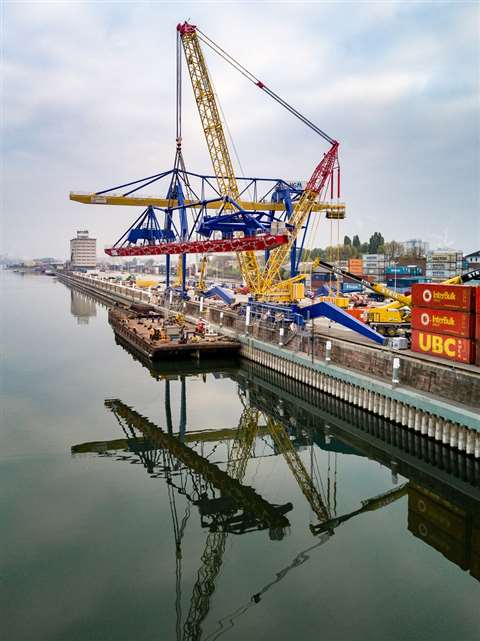Dockside pair goes up with Steil
11 July 2017

German crane company Steil chose a 650 tonne capacity lattice boom crawler crane for a project to assemble a pair of dockside cranes at the port of Mannheim.
Trier-based Steil was working on behalf of Kranwerke Mannheim. Before the cranes could be assembled, one of the main steel beams for the crane had to be loaded at Speyer Port for transport to Mannheim by ship.
Steil wanted a crane that could handle both jobs so it chose a Terex Superlift 3800, now known as a Demag CC 3800-1. Steil has seven of these in its fleet and describes them as indispensible. Sebastian Sehl, Steil project manager, said, “There’s no doubt about it – without this crane, we wouldn’t have been able to take care of these jobs with the kind of flexibility we needed. Not by a long shot.”
Steil lifted the 78 metre, 105 tonne main girder for manufacturer Tobies onto a pontoon at Speyer Port. If the lift from the truck to the pontoon had to be made at low tide the required radius could increase by up to three metres. Unlike a wheeled mobile crane, using the crawler crane allowed for this. “That’s why we planned with a variable Superlift counterweight of 65 to 125 tonnes. That allowed the crane to work flexibly with a radius of 28 to 30 metres and made sure that the job would still be feasible even at low tide,” Sehl explained.
With the pontoon loaded it left for Mannheim. On arrival Steil’s work to erect two container cranes at the shipyard involved a number of components, including the main beam. To begin with, the hinged legs for dockside crane 1 were erected with 130 and 200 tonne capacity assist cranes. At the same time, the Superlift 3800 lifted the fully assembled 241 tonne beam.
It was configured with 54 m of main boom, 50 tonnes of central ballast, 165 tonnes of superstructure counterweight, and a 54 tonne Superlift counterweight. The fully assembled beam was lifted 30 m and then the crane crawled about 15 m carrying the load. At a radius of 16 to 18 m, the crane then lifted to a height of 32 m and turned the load so that it was parallel to the dockside crane’s hinged legs, Terex said.
The legs were then bolted to the rail bogies and to the beam before the two assist cranes were moved so that they could bring the fixed legs in for installation on the bogies. “During all this work, the crane had to hold the heavy crane girder in the required position without the girder swinging back and forth, which definitely was made more difficult by the wind hitting them, but never to the point that it became critical,” Sehl said.
After that the 15 tonne trolley was lifted onto the runway girder using a pair of 200 tonne wheeled mobile cranes.




